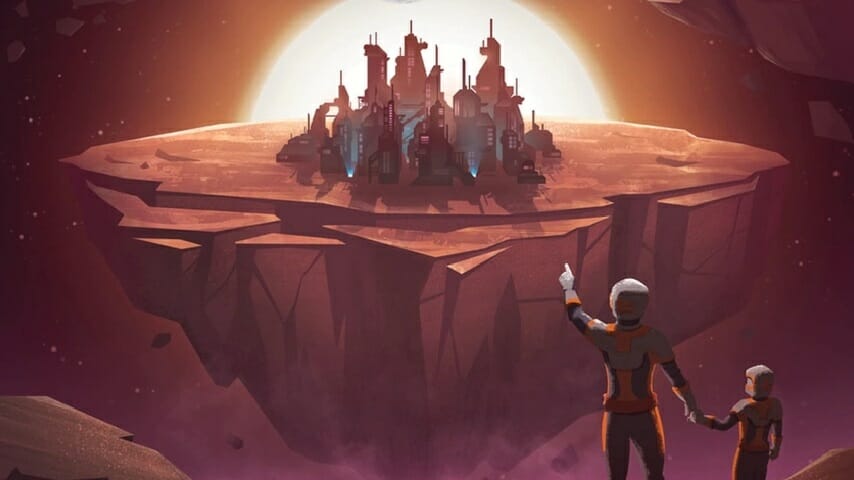
Cosmic Colonies is a perfectly pleasant new game of asteroid colonization, with quick turns and mechanics you’ve probably seen before. Designer Scott Almes is best known for his “Tiny Epic” game series and other small-box games like Claim and Harbour, but went for a larger box and bigger scale in this game, which jumps on the current craze for games that use polyomino (Tetris-like) tiles and combines it with resource management and different role cards. The whole is a bit less than the sum of the parts, though; if this is really your type of game, you might love it, but I was left feeling like I’d played this before.
In Cosmic Colonies, two to five players will compete to buy polyomino tiles from a central supply to cover up their boards, each of which is slightly different in shape and configuration but contains the same four terrain colors. In the basic game, you score for how well you covered up the first three of those terrain colors; the fewer squares of each you have left, the more points you’ll score. In the advanced game, you also score for how many of the plain squares you did leave uncovered.
The game plays out over eight rounds, with each player taking two actions per round. The actions themselves are simple—you can either collect resources of one type (there are four) from the board, or you can use resources you have to buy one of the five polyomino tiles on the central board, each of which covers four squares and has a specific cost of three resources. Players choose one of the four role cards in their hand and play them simultaneously, face-down. They’re revealed and the player whose card has the lowest number in the top left goes first. Lower-numbered cards may have lower capacity for resources—allowing you to take only two resources instead of three or four—or lack special abilities, like allowing you to build twice in a turn, or to build for one fewer resource than required. The basic and advanced games have entirely different role cards, and the advanced game adds a wrinkle where cards’ abilities vary if they’re played first in a round (“day”) or second (“night”). The advanced game boards are slightly different as well.
Those polyomino tiles are limited to five in each round for a two- or three-player game, or 10 in each round (two per type) in a four- or five-player game, so it’s quite easy to find yourself working up to buy a tile that someone else buys out from under you. You won’t be able to cover your entire board with the tiles you buy, and must place new tiles adjacent to at least one tile already on your board, so getting specific shapes to maximize your coverage of the squares that matter for scoring is essential to playing Cosmic Colonies well.
Final scoring is very straightforward. You’ll score your coverage on your boards by the three or four terrain types. You get 15 points for each complete set of all five polyomino tile types on your board. You have a private objective card for the game that also gives you two points for each of one polyomino type and one point for each of another type on your board.

Cosmic Colonies doesn’t bring anything new to the table, however. Everything about the game works reasonably well, and most mechanics within the game will be comfortably familiar to players—you gather resources, build stuff with polyomino tiles, use role cards to determine who goes when and what actions you can take (Entropy has the same mechanic, among other games), and then rotate the role cards the way you draft cards in 7 Wonders or Mesozooic. It combines mechanics in a slightly new way, but I couldn’t see myself pulling this back off the shelf against other somewhat similar games in my collection.
One major reason is that your moves don’t really build towards anything. You collect resources, buy a tile, and then collect resources again to buy the next tile with no real benefit from what you’ve done before. It’s not an engine-builder, and unlike most collect/build games, what you build doesn’t get you any further abilities or powers. It meant that the game’s theme, of building colonies on asteroids, doesn’t come through in the game play. It’s an abstract tile-laying game with nice sci-fi artwork.
This probably makes the game sound worse than it is. Cosmic Colonies works. The rules are consistent and balanced, it’s easy to learn, and plays in a reasonable time. If you like polyomino games and the space exploration theme appeals to you, you may like Cosmic Colonies more than I did. It’s also a good learning game for younger players who might enjoy the simple gather/build mechanic, without the complications of seeing those values change as the game plays out. It’s just probably not a keeper for me compared to other games that employ some of these mechanics while requiring deeper strategy.
Keith Law is the author of The Inside Game and Smart Baseball and a senior baseball writer for The Athletic. You can find his personal blog the dish, covering games, literature, and more, at meadowparty.com/blog.